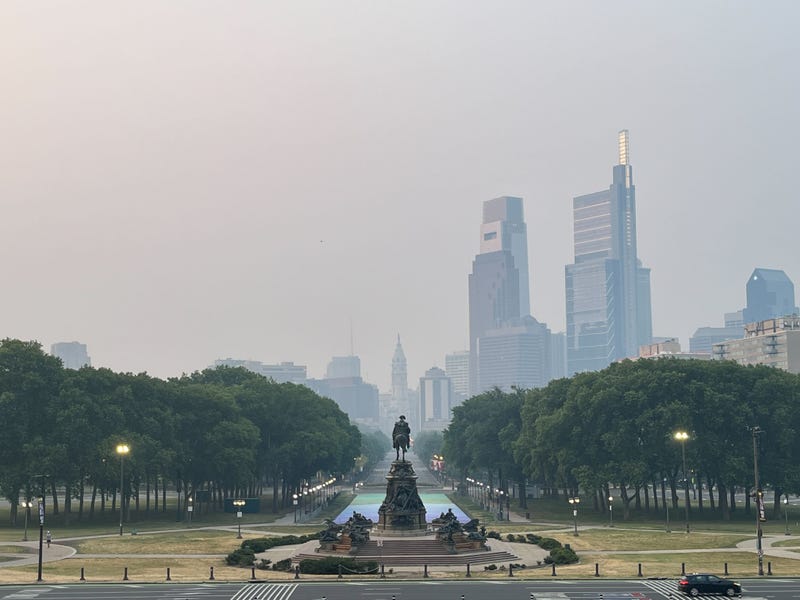
PHILADELPHIA (AP/KYW Newsradio) — Intense Canadian wildfires are blanketing the northeastern U.S. in a dystopian haze, turning the air acrid, the sky yellowish gray and prompting warnings for vulnerable populations to stay inside.
The effects of hundreds of wildfires burning across the western provinces to Quebec could be felt as far away as New York City and New England, blotting out skylines and irritating throats.
In Philadelphia, a Code Orange is in effect across the city. Health officials said the smoke grew worse in the region Tuesday night, so residents should take precautions to “avoid unnecessary exposure to smoke and avoid activities that may increase the amount of particulate matter in the air.”
These tiny particles in the air can reduce visibility, create hazy conditions and affect one’s health.
The health department recommends people avoid going outdoors as much as possible. Sensitive groups of people are especially at risk, including children, older adults, people who are pregnant, or people with respiratory diseases or heart conditions.
Hazy conditions
In the Philadelphia area, dusk brought more of a lavender haze.
Other parts of the region, like Montgomery and Bucks counties, had to send alerts to residents telling them not to call 911 because of the haziness and the smell of smoke.
The conditions are also impacting other parts of Pennsylvania, New Jersey and most of the state of Delaware, according to AirNow.gov. The federal reporting site says the air quality is "very unhealthy" across New Castle, Kent and Sussex counties, and the Wilmington area.
Find out if your region is affected here.
Smoke from Canada’s wildfires has been moving into the United States since last month. The most recent fires near Quebec have been burning for at least several days.
The U.S. Environmental Protection Agency said hazy skies, reduced visibility and the odor of burning wood are likely, and that the smoke will linger for a few days in northern states.
The National Weather Service said there should be some relief Wednesday morning, but another big plume of smoke is expected in the afternoon and evening.
What is PM 2.5?
Air quality alerts are triggered by a number of factors, including the detection of fine-particle pollution — known as PM 2.5 — which can irritate the lungs.
“We have defenses in our upper airway to trap larger particles and prevent them from getting down into the lungs. These are sort of the right size to get past those defenses,” said Dr. David Hill, a pulmonologist in Waterbury, Connecticut, and a member of the American Lung Association’s National Board of Directors. “When those particles get down into the respiratory space, they cause the body to have an inflammatory reaction to them.”
Exposure to elevated fine-particle pollution levels can affect the lungs and heart. Of people in sensitive groups, children — who often are encouraged to go out and play — are more susceptible to the smoke for a number of reasons.
“Their lungs are still developing,” said Laura Kate Bender, the lung association's national assistant vice president, healthy air. “They breathe in more air per unit of body weight.”
What can you do for now?
To help reduce the amount of pollution in the city, the Philadelphia Department of Public Health recommends residents:
— Avoid unnecessary car trips
— Avoid idling
— Carpool, when possible
— Avoid using gas-powered lawn and garden equipment
The department stresses people should avoid going outside as much as possible, so put off that yard work and outdoor exercise. If people have to go outside, avoid excessive activity and wear a mask, preferably an N95.
Close all windows, doors and fireplaces to minimize pollution. Run fans and the air conditioning on a recirculation setting.

